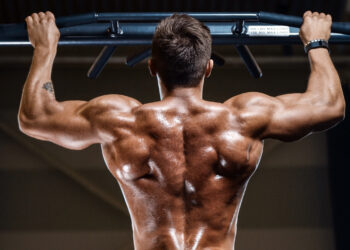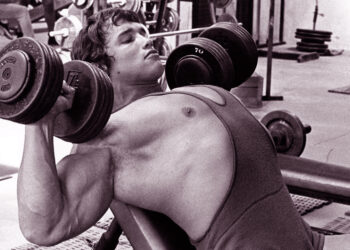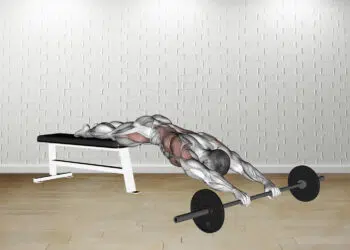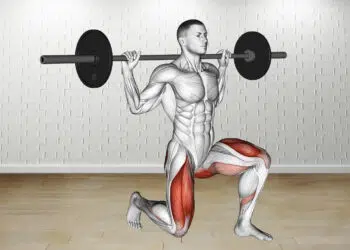Are you an overhand or underhand grip type of exerciser? Some people choose to have the best of both worlds but if you’re someone who always goes palms down, flipping your grip can be a game-changer. The reverse grip pull-up is a variation of the conventional pronated grip pull-up but the truth is many do the latter but don’t actually feel it working. Using a supinated or underhand grip can be your answer to maximizing mind-muscle connection and contraction, and it seems to result in a better stretch during the negatives.
Here’s a full guide to this must-have back movement.
How To Do The Reverse Grip Pull-Up
There’s more to the reverse grip pull-up than simply changing your grip position. That’s because the underhand wide grip will slightly change the mechanics of how you pull yourself up to a bar. Below we’ve included detailed instructions to ensure you hit the target muscle groups effectively.
Step 1: Grip
- Reach up and grasp the pull-up bar with your hands about shoulder width apart and palms facing toward you (underhand grip).
Safety tip: Avoid using a wider than shoulder width grip as it can place a lot of stress on the shoulder joints.
Step 2: Scapular positioning
- While hanging with arms fully extended, pull your shoulders down. This will ensure proper and safe movement of your scapula during the pull-up.
Safety tip: Do not allow your head to sink down into your shoulders at any point during the exercise.
Step 3: Proper leg positioning
- Keep your legs fully extended and together, then bend at your hips and lift your legs slightly in front of your body. This will help to prevent any energy leaks that may affect your pull-up strength.
Step 4: Pre-rep preparation
- Lean your torso slightly back at an angle, tighten your core, and tense your lats muscles. This will allow you to optimize the movement and perform each rep efficiently.
Step 5: The pull-up
- Drive your elbows down to your hips and pull down on the pull-up bar as hard as you can until your chin reaches the bar. Slowly lower yourself back down until you feel a stretch in your lats and take a few seconds to reset before the next rep.
Reverse Grip Pull-Up Benefits
Pull-ups are the best upper body bodyweight exercise that you can and there’s no debate. With that comes many benefits that you can read about below.
Level Up Your Fitness: Join our 💪 strong community in Fitness Volt Newsletter. Get daily inspiration, expert-backed workouts, nutrition tips, the latest in strength sports, and the support you need to reach your goals. Subscribe for free!
Build a sexy posterior chain
A muscular and toned back is one of the sexiest things about an aesthetic physique. In an Ace-sponsored study, pull-ups hit the lat back muscles better than any of the other common back exercises. Lats are large muscles that contribute a lot to the shape of your upper rear.
Get a better contraction
Many times, switching from an overhand to underhand grip will completely change the feel of an exercise. Maybe that’s because the opposite hand position causes you to move the weight up a little differently. Try this: Perform bent over rows on a Smith machine using an overhand grip, then try it with an underhand grip. While you may not, many do feel a significant difference in how the muscle contracts.
A great biceps and forearm exercise
While you can expect to build lots of muscle and strength in your back, all pulling movements heavily engage the biceps, brachialis and brachioradialis muscle groups.
Bodyweight only/equipment-free
The beauty of bodyweight exercises is you don’t need any fancy or expensive equipment. Although pull-ups do require a pull-up bar which you can find here and that are very affordable and incredibly versatile by the same token.
However, if you do choose to add more weight to your pull-ups, it’s very simple. Use a dipping belt, weighted vest/backpack, or hold a dumbbell between your feet. Voila, you have the option to increase the resistance more than you’d ever be able to.
Intensify your mind-muscle connection
Building muscle is not just lifting weights. It’s having a mental connection with your muscles during the contraction and lengthening phase of an exercise. Sure you will still build muscle lugging around weights but other muscles tend to takeover too and hence you’re not maximizing your efforts.
Read more about mind-muscle connection and why it’s key to better gains here.
Drawbacks
While the reverse grip pull-up is an excellent exercise, there are a few drawbacks.
You need upper body strength
This is obvious but you need decent upper body strength to do pull-ups. If you cannot, here are 8 ways to get better at pull-ups and chin-ups.
Grip width
Going too wide can hurt or damage your shoulders. Stay shoulder width or closer and if you want to do extra wide pull-ups, use an overhand grip.
Level Up Your Fitness: Join our 💪 strong community in Fitness Volt Newsletter. Get daily inspiration, expert-backed workouts, nutrition tips, the latest in strength sports, and the support you need to reach your goals. Subscribe for free!
Variations
We love having the options of variations and alternatives because they allow us to work all of the same muscles regardless of experience level. Plus, it’s also nice to have variety in your training to prevent boredom and keep your training fresh and exciting.
1. Assisted reverse grip pull-up
Whether you use a dedicated assisted pull-up machine or bands, assisted pull-ups are an ideal way to get better at pull-ups because you’re mimicking the movement even though you’re being helped. Not to mention, it’s much easier to adjust the resistance and keep track of your strength progression.
2. Close grip reverse pull-up
Want to really overload the biceps? Move your hands in with an inch space in between and pump out a few sets of pull-ups.
3. Reverse grip inverted or Australian pull-up
A way underrated back exercise, the inverted or Australian pull-up will too involve the same muscle groups as the conventional pull-up. What’s also great is that it’s still easier but you’re lifting only a portion of your body weight and can adjust the resistance by changing your body angle.
Check out these Best Pull Up Alternatives and Variations For All Fitness Levels.
Alternatives
1. Cable/machine reverse grip pulldown
If you want to work the same posterior muscles but without needing a pull-up bar, you cannot go wrong with the legendary cable pulldown. You can replicate the reverse grip lat movement and because you can use as little or as much weight as you like, this variation is possible for almost anyone regardless of upper body strength.
2. Reverse grip rows
Row variations are possibly the best overall back exercises because they seem to hit all of the back muscles symmetrically better than most (1). And while we’d agree deadlifts do as well, rows involve transverse adduction (pulling the arms back behind the body) which means you also get a full contraction back there.
How To Program Reverse Grip Pull-Ups In Your Back Workouts
Besides performing the standard 3 sets of 10 reps, here are some other ways to do reverse grip pull-ups.
Drop sets
One of the best muscle building intensity training techniques, drops sets are when you perform a few reps with a heavy weight before dropping the resistance and continuing to crank out more reps until you hit failure. You can do multiple drop sets within a set.
Partials
One really effective technique that will light your back and biceps on fire is to perform partial repetitions in the top half of a pull-up range of motion. We recommend doing full range of motion pull-ups until you reach a few reps shy of failure before squeezing out as many half reps as possible.
Tip: Do the full reps weighted, then drop the weight and knock out the partials in the top half.
How Many Sets and Reps?
Typically, we recommend specific sets and reps ranges based on your goals. Although, you should use all for best results. Here are some suggestions based on what you’d like to accomplish.
- Muscle endurance: 2-3 sets x 15-25+ reps
- Hypertrophy: 3 sets x 5-8 reps
- Strength: 4-5 sets x 3-5 reps
FAQs
What's the difference between a reverse grip pull-up and a chin-up?
Pull-ups are typically performed using a wider grip, so a reverse grip variation will be similar with the only difference being the hand position. You might use a closer grip for chin-ups.
Muscles Worked
While the pull-up is known to build a great back, it’s also an effective exercise for several other upper body muscle groups. Check out our brief descriptions for each one below.

- Latissimus dorsi – The largest muscles in back, latissimus dorsi take up a lot of space on the upper posterior chain from just below the shoulder blades down the spine to the pelvis and outward. It helps to adduct, medially rotate, and extend the humerus. When we pull up, swim or even breathe, the lats are involves to a large degree.
- Teres Major – A thick shoulder muscle not a part of the rotator cuff, teres major pulls the upper arm back into extension plus it medially rotates the arm and helps stabilize the shoulder joint. Wide, reverse pull-ups will do wonders for teres major development.
- Brachialis – An underappreciated muscles, brachialis is a pure elbow flexor that starts halfway up the outer upper arm and crosses the elbow joint. It takes a lot of training to bring out this muscle but when its developed, you’ll see more size in the upper arm.
- Brachioradialis – If you want to have head turning forearms, it’ll be in your best interest to target the brachioradialis. It’s located in the lateral forearm and crosses the elbow joint, acting to flex the elbow but also supinate and pronate the forearm (flipping the palm up and down respectively). Pulls and curls will help to bring out its potential.
- Deltoid Posterior – . The deltoid posterior is responsible for extension of the arm behind the body like when you perform row variations.
- Levator Scapulae – A superficial muscle on the upper back, levator scapulae elevates the scapula or shoulder blades with the surrounding trapezius and rhomboid muscles.
- Pectoralis Major Sternal Head – Sternal head is a lower chest section of muscle fibers that function to pull the arms down and inward.
- Core – A strong midsection is important for many reasons. You need good abs to support heavy lifts and keep our bodies from swinging too much during pull-ups, obliques to twist your body and lean sideways and healthy back erectors to stand upright.
Bottom Line
The reverse grip pull-up is a worthwhile variation of a classic back builder and possibly the most effective upper body bodyweight-based posterior chain exercise. When your goal is to build more muscle and increase strength, varying your grip can make a difference in muscle engagement and it’s one of the best ways to develop mind-muscle connection.
Try out this version of the pull-up next time you do a back workout session!
Interested in measuring your progress? Check out our strength standards for Pull Ups, Deadlift, Chin Ups, and more.








